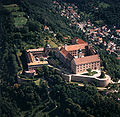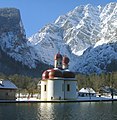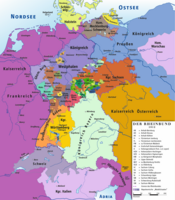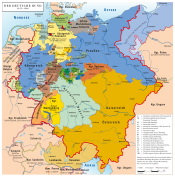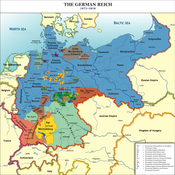Bavaria
Template:Infobox German Bundesland Bavaria (Template:Lang-de, pronounced [fraɪ.ʃtaːt ˈbaɪ.ɐn] ), with an area of 70,548 square kilometres (27,200 sq mi) and almost 12.5 million inhabitants, is located in the southeast of Germany and is the largest federal state (Bundesland) of Germany by area, forming almost 20% of the total land area of Germany. Its capital is Munich in Upper Bavaria.
It is the only modern state of Germany which never belonged to the Hanseatic League.
History
The Bavarians emerged in a region north of the Alps, originally inhabited by the Celts, which had been part of the Roman provinces of Raethia and Noricum. The Bavarians spoke Old High German but, unlike other Germanic groups, did not migrate from elsewhere. Rather, they seem to have coalesced out of other groups left behind by Roman withdrawal late in the 5th century AD. These peoples may have included the Celtic Boii, some remaining Romans, Marcomanni, Allemanni, Quadi, Thuringians, Goths, Scirians, Rugians, Heruli. The name "Bavarian" ("Baiuvarii") means "Men of Baia" which may indicate Bohemia, the homeland of the Celtic Boii and later of the Marcomanni. They first appear in written sources circa 520. Saint Boniface completed the people's conversion to Christianity in the early-8th century. Bavaria was, for the most part, unaffected by the Protestant Reformation, and even today, most of it is strongly Roman Catholic.
From about 550 to 788 the house of Agilolfing ruled the Duchy of Bavaria, ending with Tassilo III who was deposed by Charlemagne.
Three early dukes are named in Frankish sources: Garibald I may have been appointed to the office by the Merovingian kings and married the Lombard princess Walderada when the church forbade her to King Chlothar I in 555. Their daughter, Theodelinde, became Queen of the Lombards in northern Italy and Garibald was forced to flee to her when he fell out with his Frankish overlords. Garibald's successor, Tassilo I, tried unsuccessfully to hold the eastern frontier against the expansion of Slavs and Avars around 600. Tassilo's son Garibald II seems to have achieved a balance of power between 610 and 616.
After Garibald II little is known of the Bavarians until Duke Theodo I, whose reign may have begun as early as 680. From 696 onwards he invited churchmen from the west to organize churches and strengthen Christianity in his duchy (it is unclear what Bavarian religious life consisted of before this time). His son, Theudebert, led a decisive Bavarian campaign to intervene in a succession dispute in the Lombard Kingdom in 714, and married his sister Guntrud to the Lombard King Liutprand. At Theodo's death the duchy was divided among his sons, but reunited under his grandson Hucbert.
At Hucbert's death (735 AD) the duchy passed to a distant relative named Odilo, from neighbouring Alemannia (modern southwest Germany and northern Switzerland). Odilo issued a law code for Bavaria, completed the process of church organisation in partnership with St. Boniface (739), and tried to intervene in Frankish succession disputes by fighting for the claims of the Carolingian Grifo. He was defeated near Augsburg in 743 but continued to rule until his death in 748.
Middle Ages
Tassilo III (b. 741 - d. after 794) succeeded his father at the age of eight after an unsuccessful attempt by Grifo to rule Bavaria. He initially ruled under Frankish oversight but began to function independently from 763 onwards. He was particularly noted for founding new monasteries and for expanding eastwards, fighting Slavs in the eastern Alps and along the River Danube and colonising these lands. After 781, however, his cousin Charlemagne began to pressure Tassilo to submit and finally deposed him in 788. The deposition was not entirely legitimate; Dissenters attempted a coup against Charlemagne at Tassilo's old capital of Regensburg in 792, led by his own son Pippin the Hunchback, and the king had to drag Tassilo out of imprisonment to formally renounce his rights and titles at the Assembly of Frankfurt in 794. This is the last appearance of Tassilo in the sources and he probably died a monk. As all of his family were also forced into monasteries, this was the end of the Agilolfing dynasty.
For the next 400 years numerous families held the duchy, rarely for more than three generations. With the revolt of duke Henry the Quarrelsome in 976, Bavaria lost large territories in the south and south east. The last, and one of the most important, of these dukes was Henry the Lion of the house of Welf, founder of Munich. When Henry the Lion was deposed as Duke of Saxony and Bavaria by his cousin, Frederick I, Holy Roman Emperor, in 1180, Bavaria was awarded as fief to the Wittelsbach family, which ruled from 1180 to 1918. The Electoral Palatinate was also acquired by the House of Wittelsbach in 1214.
The first of several divisions of the duchy of Bavaria occurred in 1255. With the extinction of the Hohenstaufen in 1268 also Swabian territories were acquired by the Wittelsbach dukes. Emperor Louis the Bavarian acquired Brandenburg, Tirol, Holland and Hainaut for his House but released the Upper Palatinate for the Palatinate branch of the Wittelsbach in 1329. In 1506 with the Landshut War of Succession the other parts of Bavaria were reunited and Munich became the sole capital.
Modern Era
In 1623 the Bavarian duke replaced his relative, the Count Palatine of the Rhine in the early days of the Thirty Years' War and acquired the powerful prince-electoral dignity in the Holy Roman Empire, determining its Emperor thence forward, as well as special legal status under the empire's laws. Also the Upper Palatinate was reunited with Bavaria. The ambitions of the Bavarian prince electors led to several wars with Austria during the early-18th century. From 1777 onwards Bavaria and the Electoral Palatinate were governed in personal union again.
Kingdom of Bavaria
When Napoleon abolished the Holy Roman Empire, Bavaria became a kingdom in 1806, and its area doubled. Tirol and Salzburg were temporarily reunited with Bavaria but finally ceded to Austria. In return the Rhenish Palatinate and Franconia were annexed to Bavaria in 1815. Between 1799 and 1817 the leading minister count Montgelas followed a strict policy of modernisation and laid the foundations of administrative structures that survived even the monarchy and are (in their core) valid until today. In 1818 a modern constitution (by the standards of the time) was passed, that established a bicameral Parliament with a House of Lords (Kammer der Reichsräte) and a House of Commons (Kammer der Abgeordneten). The constitution was valid until the collapse of the monarchy at the end of World War I.
Bavaria as a part of the German Empire
After the rise of Prussia to prominence Bavaria managed to preserve its independence by playing off the rivalries of Prussia and Austria. It was defeated in the 1866 Austro-Prussian War and did not belong to the North German Federation of 1867, but the question of German unity was still alive. When France attacked Prussia in 1870, the south German states Baden, Württemberg and Bavaria joined the Prussian forces and ultimately joined the Federation, which was renamed Deutsches Reich (German Empire) in 1871. Bavaria continued in being a monarchy, and it even had some special rights within the federation (such as an army and a postal service of its own).
In the early-20th century Wassily Kandinsky, Paul Klee, Henrik Ibsen, and other notable artists were drawn to Bavaria, notably to the Schwabing district of Munich, later devastated by World War II.

20th century
On November 12 1918 Ludwig III signed a document, the Anif declaration, releasing both civil and military officers from their oaths; the newly-formed republican government of Socialist premier Kurt Eisner interpreted this as an abdication. Eisner was assassinated in 1919 leading to a violently suppressed Communist revolt. Extremist activity by the National Socialists also increased, notably the 1923 Beer Hall Putsch, and Munich and Nuremberg became Nazi strongholds under the Third Reich. As a manufacturing center, Munich was heavily bombed during World War II and occupied by U.S. troops. The Rhenish Palatinate was detached from Bavaria in 1946 and made part of the new state Rhineland-Palatinate.
Since World War II, Bavaria has been rehabilitated into a prosperous industrial hub. A massive reconstruction effort restored much of Munich's historic core, and the city hosted the 1972 Summer Olympics. More recently, former state minister-president Edmund Stoiber was the CDU/CSU candidate for chancellor in the 2002 federal election which he lost, and native son Cardinal Joseph Ratzinger was elected Pope Benedict XVI in 2005.
Geography

Bavaria shares international borders with Austria and the Czech Republic as well as with Switzerland (across Lake Constance). Neighbouring states within Germany are Baden-Württemberg, Hesse, Thuringia and Saxony. Two major rivers flow through the state, the Danube (Donau) and the Main, and the upper Rhine forms part of the southwest border of the state. The Bavarian Alps define the border with Austria, and within the range is the highest peak in Germany, the Zugspitze.
The major cities in Bavaria are Munich (München), Nuremberg (Nürnberg), Augsburg, Würzburg, Regensburg, Ingolstadt, Fürth and Erlangen.
Population and area
| Administrative region | Population (2008) | Area (km²) | No. municipalities | |||
|---|---|---|---|---|---|---|
| Lower Bavaria | 1,193,444 | 9.5% | 10,330 | 14.6% | 258 | 12.5% |
| Lower Franconia | 1,331,500 | 10.6% | 8,531 | 12.1% | 308 | 15.0% |
| Upper Franconia | 1,085,770 | 8.7% | 7,231 | 10.2% | 214 | 10.4% |
| Middle Franconia | 1,714,453 | 13.7% | 7,245 | 10.3% | 210 | 10.2% |
| Upper Palatinate | 1,085,216 | 8.7% | 9,691 | 13.7% | 226 | 11.0% |
| Swabia | 1,787,995 | 14.3% | 9,992 | 14.2% | 340 | 16.5% |
| Upper Bavaria | 4,320,934 | 34.5% | 17,530 | 24.8% | 500 | 24.3% |
| Total | 12,519,312 | 100.0% | 70,549 | 100.0% | 2,056 | 100.0% |
Major cities
| City | Inhabitants 31 December 2000 |
Inhabitants 31 December 2005 |
Inhabitants 31 March 2007 |
|---|---|---|---|
| Munich | 1,210,223 | 1,259,677 | 1,298,354 |
| Nuremberg | 488,400 | 499,237 | 500,591 |
| Augsburg | 254,982 | 262,676 | 262,371 |
| Würzburg | 127,966 | 133,906 | 134,225 |
| Regensburg | 125,676 | 129,859 | 131,489 |
| Ingolstadt | 115,722 | 121,314 | 122,213 |
| Fürth | 110,477 | 113,422 | 113,848 |
| Erlangen | 100,778 | 103,197 | 103,859 |
| Bayreuth | 74,153 | 73,997 | 73,252 |
| Bamberg | 69,036 | 70,081 | 69,558 |
| Aschaffenburg | 67,592 | 68,642 | 68,672 |
| Landshut | 58,746 | 61,368 | 62,074 |
| Kempten (Allgäu) | 61,389 | 61,360 | 61,454 |
| Rosenheim | 58,908 | 60,226 | 60,438 |
| Schweinfurt | 54,325 | 54,273 | 53,917 |
| Neu-Ulm | 50,188 | 51,410 | 51,755 |
| Passau | 50,536 | 50,651 | 50,464 |
| Hof | 50,741 | 48,723 | 48,040 |
| Freising | 44,167 | 45,827 | 46,110 |
| Straubing | 44,014 | 44,633 | 44,762 |
Administrative divisions
Regierungsbezirke (administrative districts)

Bavaria is divided into 7 administrative districts called Regierungsbezirke (singular Regierungsbezirk).
- Upper Franconia (Template:Lang-de)
- Middle Franconia ([Mittelfranken] Error: {{Lang}}: text has italic markup (help))
- Lower Franconia ([Unterfranken] Error: {{Lang}}: text has italic markup (help))
- Swabia ([Schwaben] Error: {{Lang}}: text has italic markup (help))
- Upper Palatinate ([Oberpfalz] Error: {{Lang}}: text has italic markup (help))
- Upper Bavaria ([Oberbayern] Error: {{Lang}}: text has italic markup (help))
- Lower Bavaria ([Niederbayern] Error: {{Lang}}: text has italic markup (help))
- Coat of Arms
-
Upper Bavaria
-
Lower Bavaria
-
Upper Palatinate
-
Upper Franconia
-
Middle Franconia
-
Lower Franconia
-
Swabia
These administrative regions consist of 71 administrative districts (called Landkreise, singular Landkreis) and 25 independent cities (kreisfreie Städte, singular kreisfreie Stadt).
Bezirke
Bezirke (districts) are the third communal layer in Bavaria; the others are the Landkreise and the Gemeinden or Städte. In the larger Länder of Germany (including Bavaria) there are Regierungsbezirke which are only administrative divisions and not self-governing entities as the Bezirke in Bavaria. The Bezirke in Bavaria are territorially identical with the Regierungsbezirke (e.g. Regierung von Oberbayern), but are a different form of administration (having their own parliaments etc.).
Landkreise/kreisfreie Cities

Landkreise:
Kreis-free Cities:
|
Gemeinden (municipalities)
The 71 administrative districts are on the lowest level divided into 2031 municipalities (called Gemeinden, singular Gemeinde). Together with the 25 independent cities (which are in effect municipalities independent of Landkreis administrations), there are a total of 2056 municipalities in Bavaria.
In 44 of the 71 administrative districts, there are a total of 215 unincorporated areas (as of January 1, 2005, called gemeindefreie Gebiete, singular gemeindefreies Gebiet), not belonging to any municipality, all uninhabited, mostly forested areas, but also four lakes (Chiemsee-without islands, Starnberger See-without island Roseninsel, Ammersee, which are the three largest lakes of Bavaria, and Waginger See).
Politics
Bavaria has a multi-party system where the biggest parties are the conservative Christian Social Union of Bavaria (CSU), which has dominated politics since 1957 and won every election since then, and the center-left Social Democratic Party of Germany (SPD). The German green party, Alliance '90/The Greens is represented in the parliament as well. Since 2008 Germany's liberal party, the Free Democratic Party and the Free Voters are represented in Bavaria's parliament as well. CSU and FDP have agreed in October 2008 to build a coalition whereas SPD, Free Voters and the Greens form the opposition.
Bavaria has a unicameral Landtag, or state parliament, elected by universal suffrage. Until December 1999, there was also a Senat, or Senate, whose members were chosen by social and economic groups in Bavaria, but following a referendum in 1998, this institution was abolished. The head of government is the Minister-President.
In 1995 Bavaria introduced direct democracy on the local level in a referendum. This was initiated bottom-up by an association called Mehr Demokratie (More Democracy). This is a grass-roots organization which campaigns for the right to citizen-initiated referendums. In 1997 the Bavarian Supreme Court aggravated the regulations considerably (e.g. by introducing a turn-out quorum). Nevertheless, Bavaria has the most advanced regulations on local direct democracy in Germany. This has led to a spirited citizens’ participation in communal and municipal affairs – 835 referenda took place from 1995 through 2005.
In the 2003 elections the CSU won more than two thirds of the seats in Landtag - something no party had ever achieved in post-war German history. In the 2008 elections the CSU lost its absolute majority in the Landtag for the first time in 46 years.[1]
Economy
Bavaria has long had one of the largest and healthiest economies of any region in Germany, or Europe for that matter.[2] Its GDP in 2007 exceeded 434 billion Euros (about 600 bn US$)[3] This makes Bavaria itself one of the largest economies in Europe and the 18th largest in the world.[4] Some large companies headquarted in Bavaria include BMW, Siemens, Audi, Munich Re, Allianz, Infineon, MAN, Wacker Chemie, Puma AG, Adidas AG, and the 17th-century brewery Königsbacher. (See also #Company names.)
Culture


Some features of the Bavarian culture and mentality are remarkably distinct from the rest of Germany. Noteworthy differences (especially in rural areas, less significant in the major cities) can be found with respect to:
Religion
The predominant faith is Roman Catholicism, particularly in the southern parts of Bavaria and Lower Franconia. As per the most recent available Kirchliche Statistik Eckdaten from the Deutsche Bischofskonferenz, Bavaria is one of two Bundesländer with a population that is in majority Catholic (though in several additional Bundesländer, a plurality of the population is Catholic). This source indicates that in 2007, 56.4% of the Bavarian population was Catholic.
In addition, Lutheranism has a significant presence in large parts of Franconia. Religion remains important to many in the region, as expressed by the typical Bavarian, Austrian and Swabian greeting: "Grüß Gott!" (Greet God!). The current pope, Benedict XVI (Joseph Alois Ratzinger), was born in Marktl am Inn in Upper Bavaria and was Archbishop of Munich and Freising.
Attitude toward traditions
Bavarians commonly emphasize pride in their traditions. Traditional costumes collectively known as Tracht are worn on special occasions and include in Altbayern Lederhosen for males and Dirndl for females. Century-old folk music is practiced. The Maibaum, or Maypole (which in the Middle Ages served as the community's yellow pages, as figurettes on the pole represent the trades of the village), and the bagpipes in the Upper Palatinate region bear witness to the ancient Celtic and Germanic remnants of cultural heritage of the region.
Food and drink
Bavarians tend to place a great value on food and drink. Bavarians also consume many items of food and drink which are unusual elsewhere in Germany; for example Weißwurst (“white sausage”). At folk festivals, beer is traditionally served by the litre (the so-called Maß). Bavarians are particularly proud of the traditional Reinheitsgebot, or purity law, initially established by the Duke of Bavaria in 1516. According to this law, only three ingredients were allowed in beer: water, barley, and hops. In 1906 the Reinheitsgebot made its way to German law, and remained a law in Germany until the EU struck it down recently as incompatible with the European common market. Bavarians are also known as some of the world's most beer-loving people with an average annual consumption of 170 liters per person.
Bavaria is also home to the Franconia wine region, which is situated along the Main River in Franconia. The region has produced wine for over 1,000 years and is famous for its use of the Bocksbeutel wine bottle. The production of wine forms an integral part of the regional culture, and many of its villages and cities hold their own wine festivals (Weinfests) throughout the year.

Language and dialects

Three German dialects and languages are spoken in Bavaria: Austro-Bavarian in Old Bavaria (South East and East), Swabian German (an Alemannic German dialect) in the Bavarian part of Swabia (South West) and East Franconian German in Franconia (North). Bavarians are very proud of their marked dialects, and most of them speak with their Bavarian, Franconian or Swabian accent. As with traditions in general, cultivation of dialect and regional accent is considered a strengthening of regional identity.
Ethnography
Bavarians consider themselves to be egalitarian and informal. Their sociability can be experienced at the annual Oktoberfest, the world's largest beer festival, which welcomes around six million visitors every year, or in the famous beer gardens. In traditional Bavarian beer gardens, patrons bring their own food and only buy beer from the brewery that runs the beer garden. [citation needed]
In the United States, particularly among German Americans, Bavarian culture is viewed somewhat nostalgically, and many "Bavarian villages", most notably Frankenmuth, Michigan and Leavenworth, Washington, have been founded. Since 1962, the latter has been styled with a Bavarian theme; it is also home to "one of the world's largest collections of nutcrackers" and an Oktoberfest celebration it claims is among the most attended in the world outside of Munich.[5]
Historical buildings
-
Johannisburg Castle in Aschaffenburg
-
Fortress Marienberg and the Alte Mainbrücke in Würzburg
-
Plassenburg Castle in Kulmbach
-
Cathedral in Bamberg
-
Castle of Coburg
-
Imperial Castle in Nürnberg
-
Kastell Biriciana, Weißenburg close to the Limes
-
Castle of Neuburg an der Donau
-
Old Stone Bridge and Cathedral of Regensburg
-
Walhalla temple in Donaustauf near Regensburg
-
Befreiungshalle in Kelheim
-
Cathedral and Oberhaus fortification in Passau
-
Trausnitz castle, Landshut
-
Townhall in Augsburg
-
Frauenkirche in Munich
-
Residenz in Munich
-
Nymphenburg Palace in Munich
-
Cathedral in Freising
-
Wieskirche, Steingaden
Famous people
There are many famous people who were born or lived in present-day Bavaria:
- Popes Pope Benedict XVI—he is the current Pope of the Roman Catholic Church (his baptismal name is Joseph Ratzinger); Pope Damasus II and Pope Victor II.
- Painters such as Hans Holbein the Elder, Albrecht Dürer, Albrecht Altdorfer, Lucas Cranach, Carl Spitzweg, Franz von Lenbach, Franz von Stuck, Franz Marc, Paul Klee, Erwin Eisch, Gabriele Munter.
- Musicians such as Orlando di Lasso, Christoph Willibald Gluck, Richard Wagner (originally from Saxony), Richard Strauss, Carl Orff, Johann Pachelbel and Theobald Boehm, the inventor of the modern flute, and countertenor Klaus Nomi.
- Modern musicians like Klaus Doldinger and Barbara Dennerlein.
- Opera singers like Diana Damrau.
- Writers, poets and playwrights like Hans Sachs, Jean Paul, Frank Wedekind, Christian Morgenstern, Oskar Maria Graf, Bertolt Brecht, Lion Feuchtwanger, Thomas Mann and his sons Klaus and Golo Mann, Karl Marx lived in Munich for a few years.
- Scientists such as Max Planck, Wilhelm Conrad Röntgen, and Werner Heisenberg, as well as Adam Ries, Joseph von Fraunhofer, Georg Ohm, Johannes Stark, Carl von Linde, Rudolf Moessbauer, Helmut Hirt and Robert Huber.
- Well-known inventors such as Martin Behaim, Levi Strauss and Rudolf Diesel.
- Physicians like Max Joseph von Pettenkofer, Sebastian Kneipp and the neurologist Alois Alzheimer, who first described Alzheimer's Disease.
- Soccer players like Max Morlock, Karl Mai, Franz Beckenbauer, Sepp Maier, Gerd Müller, Paul Breitner, Bernd Schuster, Klaus Augenthaler, Lothar Matthäus, Dietmar Hamann and Stefan Reuter
- Actors like Werner Stocker.
- Film directors Rainer Werner Fassbinder, Joseph Vilsmaier and Werner Herzog.
- Mysterious people: Kaspar Hauser (the famous foundling), The Smith of Kochel (legend).
- Sportsman like Bernhard Langer (golf)
- Legendary outlaws such as Mathias Kneißl, the legendary robber or Matthias Klostermayr, better known as Bavarian Hiasl
- Dictator: Adolf Hitler lived in Munich for a while in the 1920s before his uprise in the 1930s.
Company names
The motorcycle and automobile makers BMW (Bayerische Motoren-Werke, or Bavarian Motor Works) and Audi, Allianz, Grundig (consumer electronics), Siemens (electricity, telephones, informatics, medical instruments), Continental (Automotive Tire and Electronics), Adidas, Puma, HypoVereinsbank (UniCredit Group), Infineon and Krauss-Maffei Wegmann have (or had) a Bavarian industrial base.
The iconic, opening scenes of the 1965 Rodgers and Hammerstein film musical The Sound of Music were shot in the Bavarian Alps.
Bavaria has also given its name to a major Dutch brewery, Bavaria Brewery.
The meaning of the coat of arms

Modern coat of arms was designed by Eduard Ege in 1946, following heraldic traditions.
- The Golden Lion: At the dexter chief, sable, a lion rampant Or, armed and langued gules. This represents the administrative region of Upper Palatinate.
- The "Franconian Rake": At the sinister chief, per fess dancetty, gules and argent. This represents the administrative regions of Upper, Middle and Lower Franconia.
- The Blue Panther: At the dexter base, argent, a panther rampant azure, armed Or and langued gules. This represents the regions of Lower and Upper Bavaria.
- The Three Lions: At the sinister base, Or, three lions passant guardant sable, armed and langued gules. This represents Swabia.
- The White-And-Blue Heart-Shaped Shield: The heart-shaped shield of white and blue fusils askance was originally the coat of arms of the Counts of Bogen, adopted in 1247 by the Wittelsbachs House. The white-and-blue fusils are indisputably the emblem of Bavaria and the heart-shaped shield today symbolizes Bavaria as a whole. Along with the People's Crown, it is officially used as the Minor Coat of Arms.
- The People's Crown: The four coat fields with the heart-shaped shield in the centre are crowned with a golden band with precious stones decorated with five ornamental leaves. This crown appeared for the first time in the coat of arms in 1923 to symbolize sovereignty of the people after the dropping out of the royal crown.
Bavarian citizenship
The fact that unlike all other German Länder, Bavaria's constitution provides for Bavarian citizenship is often mentioned as an indicator for Bavarian distinctiveness. Some Bavarians are keen to emphasize that - in accordance with the generous indication of the constitution — they regard everyone
- born in Bavaria,
- born to a Bavarian parent,
- adopted by a Bavarian as a child,
- married to a Bavarian, or
- naturalized in Bavaria,
as a fellow-Bavarian; some of those falling under this untechnical definition express pride in being Bavarian. However, state legislation regulating citizenship procedures has never been enacted, the constitution itself provides that all Germans enjoy the same rights as Bavarian citizens, and no office issues certificates concerning a "Bavarian" citizenship. Thus, the notion of citizenship rather bears a folkloristic, but not really political meaning.
However, many of those born in Bavaria clearly divide between born Bavarians and people that only moved to Bavaria. The nickname for all those who came to Bavaria is Zuagroaste (Zugereiste = those who have moved here).
Some people in the northern part of Bavaria see themselves as Franconians and do therefore not like to be called Bavarians. They have a separate dialect and don't wear traditional Bavarian clothing.
German-Bavarian relations
It is a common joke in Germany that Bavaria is not part of Germany. In fact a minority seriously agrees with this notion; the Bayernpartei (Bavaria Party) advocates Bavarian independence from Germany. It is important to note that Bavaria was the only state to reject the West German constitution in 1949. However this has had no consequences on its implementation. Furthermore, many NGOs (non-governmental organizations) have a German and a dedicated Bavarian branch. The main disintegrated factor might seem to be the fact that Bavaria has its very own political party (CSU) representing the free state in the Bundestag. However, the CSU always cooperates with CDU (Christian Democratic Union)[6], forming factions and building up the government with it. Thus, the existence of a dedicated party is not necessarily a disintegrating factor and is rather seen as a sign for political diversity in Germany. Bavaria fielded a border police force, much like the Federal German Grenzschutz, during the Cold War.
Bavarian culture overseas
The Bavarians take great pride in their culture. Traditions are taught to the children and descendants of Bavarian citizens through literature, music and cultural events. Whether actually in Bavaria, overseas or full citizens of other nations they continue to cultivate their traditions. They hold festivals and dances to keep their traditions alive. In New York the German American Cultural Society is a larger umbrella group for others such as the Bavarian organizations, which represent a specific part of Germany. They proudly put forth a German Parade called Steuben Parade each year. Various affiliated events take place amongst its groups, one of which is the Bavarian Dancers.
See also
- List of rulers of Bavaria
- List of Premiers of Bavaria
- Former countries in Europe after 1815
- Extensive pictures of Bavaria in addition to those shown below are linked from in Category:Bavaria, where they are organized (predominantly) by locale.
References
- ^ n-tv:Fiasko für die CSU
- ^ Its GDP is 143% of the EU average (as of 2005) against a German average of 121.5%, see Eurostat
- ^ Gemeinsames Datenangebot der Statistischen Ämter des Bundes und der Länder
- ^ See the list of countries by GDP (nominal).
- ^ Leavenworth, Washington The Bavarian Village
- ^ Grüß Gott auf den Internetseiten der CSU











